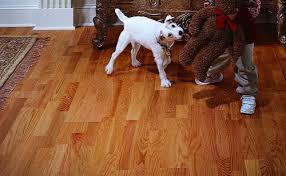Cleaning Hardwood Floors
Your hardwood floor is installed. There is no flooring that looks as comfortable or luxurious as a beautiful hardwood floor. How do you care for and clean Hardwood flooring? It is an investment you certainly want to protect. Most major stores will have hardwood floor basics for equipment and supplies for cleaning hardwood floors. You may find some specialty pieces of equipment at flooring stores.
Floor mats are essential when it comes to cleaning hardwood floors. Tiny particles, like dirt, can act like sandpaper and scratch your wood. A floor mat at each entryway and having family members and guests to wipe their feet, the majority of dirt and grime will remain on the mat. Having a good mat before and after you go in your home goes a long way to trap the dirt before you enter the house. Try and use over sized mats where you can and regularly sweep or vacuum them as well. Also put a floor mat or rug in any area where water could be splashed — like near the kitchen sink. This will hinder any possible water damage.
Note that rubber-backed or non-ventilated floor mats or rugs can damage your floor. Instead use floor mats or rugs made especially for hardwood floors or use hardwood floor pads under the mat. It is pretty important to keep under the mats clean as well a build up of dirt and the movement of the mat will cause damage to the floors.

Cleaning Hardwood Floors
The more frequently you clean the easier it is to keep your hardwood floors clean, and the better care you take, the longer your floor will maintain its original beauty. Step one is to purchase a high quality broom so that you can sweep your floor regularly of dirt, dust and other particles.
Second step is a vacuum cleaner without a beater bar, to get in between the boards and other hard to reach areas. Be sure your vacuum tool is always in good repair and the brushes are good, once they wear you don’t want the actual tool to start scratching the hardwood floors.
Deeper cleaning techniques vary depending on the installation and finish of your hardwood floor. For “Finish in Place” hardwood floors, using an 8”x14” terrycloth mop with a rotating head that makes cleaning corners, under cabinets and along base boards as simple. In any case always use very little water this is why standard mops not recommended to clean hardwood floors. A flat hardwood floor mop leaves little space for water and is always best.
Professional cleaning products recommended by your flooring retailer can be used to remove tough stains and spills without dulling the finish of your wood floor. Makers of “Pre-finished” floors recommend their own specific products for routine maintenance. Check with your retailer for details.
Do and Don’ts
Don’t wax a wood floor with a urethane finish
Do use cleaners that won’t leave a film or residue
Don’t use ammonia cleaners or oil soaps on a wood floor — they’ll dull the finish and affect your ability to recoat later.
Do use a professional hardwood floor cleaner to remove occasional scuffs and heel marks (just spray some cleaner on a cloth and rub the stained area lightly)
Don’t wet mop or use excessive water to clean your floor (wood naturally expands when it’s wet and can cause your floor to crack or splinter).
Do clean sticky spots with a damp towel or sponge
Do minimize water exposure and clean spills immediately
If and when your hardwood floor begins to look like it belongs beneath the feet of gold miners in an old western saloon, it’s time to consider screening and re-coating.
Screening is the process used to abrade or grind down your floor’s polyurethane finish. Next, fresh coats of urethane are applied. The result is a rejuvenated floor that looks as good as the day it was installed!
If the damage to your hardwood floor is severe, then you may require sanding and refinishing. This process involves sanding your floor down to the bare wood and refinishing it. Only go to this effort if screening and re-coating doesn’t solve your problem. Replacement boards may be available so you don’t have to refinish the entire area. Be sure to go pro whenever you have work done on your hardwood floors!
Final Thoughts
All hardwood floors fade or change shades over time. Like our own skin, wood’s exposure to sunlight may greatly increase this process and cause permanent damage.
Window treatments are recommended to shade your floors from the sun’s harsh rays. We also recommend rotating area rugs and furniture regularly, allowing wood floors to age evenly from UV exposure.
To avoid permanent marks and scratches, it’s a good idea to cover furniture and table legs with flannel protectors. Be careful when moving heavy objects across your floor to avoid scuffing.
Ladies — your stiletto heels may be fashionable, but what’s not in fashion (or covered by your warranty) are the dents and scratches they cause to wood floors. I had a friend who held a big dinner party after installing new hardwood floors only to wake up to hundreds of little dents in his brand new (and now not so perfect) hardwood floors. So have a dinner party but keep it casual, nothing fancy. Likewise, trim your pet’s nails regularly and keep any and all other sharp objects (don’t walk with scissors is a good rule always) away from your floors.
Follow these basic tips for clean hardwood floors that stand the test of time for years to come.
Source: http://www.howtocleananything.com





